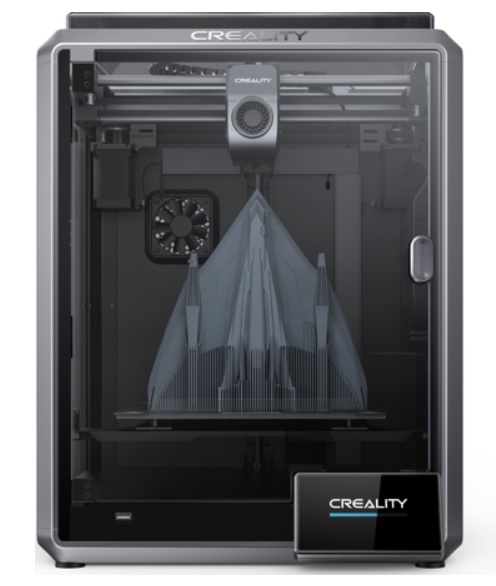Compare Comgrow T300 vs K1
Comparison between the best 3D printers
Choose the best 3D printer at the best price. The cheapest 3D printers are here.
Buy a 3D printer here with 3D Fila.
 |
 |
|
| Model | Comgrow T300 |
K1[BUY K1] |
| Printing Material | Filament | Filament |
| Buy Filament for Sovol Comgrow T300 | Buy Filament forCreality 3D K1 | |
| Estimated price | $449,00 | $399,00 |
| Manufacturer | Sovol | Creality 3D |
| Release Year | 2024 | 2023 |
| Print Volume [mm] | 300x300x350 | 220x220x250 |
| Printer Size [mm] | 503x631x831 | 355x355x480 |
| Weight [kg] | 17 | 12,5 |
| Power Loss Recovery | YES | YES |
| Enclosed printer | NO | YES |
| Bed Leveling | Automatic | Automatic |
| Filament End Sensor | YES | YES |
| Bed type | Heated | Heated |
| Power supply system | Direct Drive | Direct Drive |
| Standard nozzle | 0,4 | 0,4 |
| Maximum Nozzle Temperature [°C] | 300 | 300 |
| Maximum Bed Temperature [°C] | 100 | 120 |
| Maximum printing speed [mm/s] | 600 | 600 |
| Filament holder | YES | YES |
| Camera for supervision | NO | NO |
| Recommended filaments | PLA, PETG, PET, TPU, PA, ASA, PC, PLA CE, PA-CF, PET-CF | ABS, PLA, PETG, PET, TPU, PA, ABS, ASA, PC, PLA-CF, PA-CF, PET-CF |
| Recommended slicers | Bambu Studio, Super Slicer, Cura, Prusa Slicer, Orca Slicer | Creality Print; Cura, Simplify3D e PrusaSlicer |
| Maximum Resolution [mm] | 0,1 | 0,1 |
| Processor | 64 bit | |
| Display | Touchscreen 5'' | Display touchscreen 4,3'' |
| Power Supply | 150 W | 110/220V / 350W |
| Connectivity | USB, WiFi | Ethernet / USB / Wi-Fi |
| Operating systems | Windows, Linux, Macbook | Windows, Mac, Linux |
| Date of registration in the system | 2024-05-10 | 2023-04-17 |
| Release date | 2024 | 2023 |
| Extra features | The Sovol Comgrow T300 printer stands out for its technological innovations and advanced features. With a print size of 300mm300mm350mm, the T300 offers true linear rails on all axes, ensuring greater stability. Its Klipper-based intelligent core and 64-bit microcomputer increase printing speed and quality through pressure advancement and input shaping. The extruder with a gear ratio of 6.5:1 allows for more precise material control, optimizing the printing of flexible materials. In addition, the T300 features a rapid filament cooling system with a high-speed fan and a circular duct piece that improves cooling efficiency. With a 4.3-inch high-refresh rate touchscreen and an 81-point automatic leveling system, the T300 simplifies the preparation and execution of 3D prints. | The K1 is an extremely fast FDM 3D printer, reaching 600mm/s, 12 times faster than standard models. Equipped with a Core XY system and lightweight print head, it offers energy efficiency and high print quality. It stands out for its dual-gear extruder and quickly heated hotend, as well as dual cooling to prevent warping. Its robust structure ensures stability at high speed, with optimized software to speed up the printing process. |
| Support for multiple colors and materials (AMS and CFS) | NO | NO |
Notes * |
||
| Cost-benefit | 8 / 10 | 8 / 10 |
| Hardware | 3.6 / 10 | 4.8 / 10 |
| Tela | . | . |
| Print volume | 4 / 10 | 3 / 10 |
| Performance | 5 / 10 | 5 / 10 |
| [BUY K1] |
Conclusion |
| In comparing the Sovol Comgrow T300 and the Creality 3D K1, both printers exhibit strong features that cater to various user needs in the 3D printing space. The Comgrow T300 offers a larger print volume and several advanced technologies, including true linear rails for enhanced stability and a high-speed cooling system for improved print quality. Its comprehensive automatic leveling system and touchscreen display contribute to a user-friendly experience, especially for those who may be newer to 3D printing. On the other hand, the K1 shines with its remarkable speed, benefitting from a Core XY system and lightweight components which enable it to print much faster than conventional models. Although its print volume is smaller, the K1's robust construction and advanced engineering make it adept at high-speed printing without sacrificing quality. Both printers have automatic bed leveling, filament end sensors, and support for multiple materials, making them versatile options for hobbyists and professionals alike. While the T300 has a slight edge in build size and advanced features, the K1's speed and efficiency could be more appealing to users looking for quick turnaround times. In terms of pricing, both models are competitively positioned, offering good value for their respective capabilities. Ultimately, the choice between the two would hinge on the specific requirements of the user: those needing larger print volumes and a feature-rich experience may prefer the T300, while those prioritizing speed and efficiency might lean towards the K1. Both printers have received commendations in terms of cost-effectiveness, suggesting that either option provides solid value in the current 3D printing market. |

